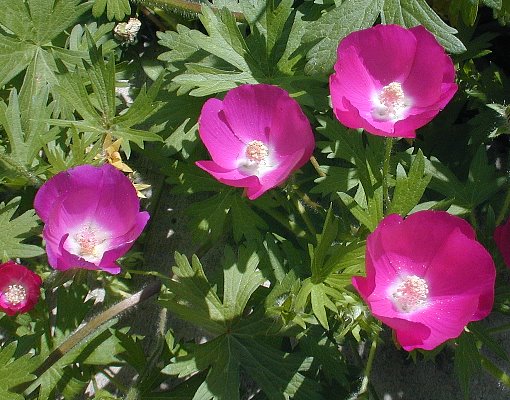Perennial herb to 1 m tall
Leaves: alternate, stalked, somewhat round in outline, but with five to seven, deep, palmate, inversely lance-shaped lobes which are further lobed or deeply toothed. The leaves also have persistent, relatively large (0.5 - 1.5 cm long), egg-shaped stipules at the base of their stalks.
Flowers: several, in axils of upper leaves or bracts, single on 3 - 10 cm long stalks, red to purple, 4 - 6 cm diameter, radially symmetric with five sepals alternating five spreading petals, and three, hairy, 0.8 - 1.7 cm long, lance-shaped bractlets immediately subtending the sepals. The flowers on an individual plant are either all female (pistillate), or all flowers have both male and female reproductive parts (perfect), which means the species is gynodioecious.
Sepals: five, but fused at very base, then separating into five, 0.9 - 1.6 cm long, lance-shaped, strongly three- to five-nerved lobes with 4.5 - 10 mm long, narrow, pointed tips. The base of the calyx is covered with short (1 - 3 mm), stiff, spreading hairs.
Petals: five, spreading, red or purple, with white basal spot, elongate wedge-shaped with narrower base and abruptly flattened tip. While the petals are always longer than the sepals, those of the perfect flowers (both male and female) are much longer (2 - 3.2 cm) than the female-only (pistillate) flowers (0.9 - 2 cm).
Stamens: numerous, but filaments fused into a tube with anthers protruding above the middle. The anthers are only functional in the perfect flowers, while the pistillate flowers have fewer and sterile anthers.
Pistil: enclosed by the stamen tube, with ten to twenty superior carpels (ovule-bearing structures), ten to twenty slender styles coming up through center of stamen tube, and ending with exserted, slender stigmas facing inward.
Fruit: a ball-like structure of ten to twenty, one-seeded, hardened, veiny-wrinkled, pitted, somewhat appressed-hairy, almost circular wedges (mericarps) subtended and partially enclosed by the persistent sepals.
Stems: ascending or decumbent, rough-hairy, and arising from a deep, spindle-shaped, perennial root.
Similar species: Callirhoe involucrata is similar to C. alcaeoides, but that species lacks bractlets just below the sepals, and its leaves are typically longer than wide. Also similar is C. triangulata, but that species has leaves that are much longer than wide and much less lobed or incised, the flowers are clustered, the sepals are less than 7 mm long, and the fruit segments are not wrinkled or pitted. There are two varieties of C. involucrata, the typical variety as described here, and C. involucrata var. lineariloba, is only found in the states of Colorado, Kansas, Oklahoma, New Mexico, Texas, and Florida.
Flowering: May to August
Habitat and ecology: Localized, likely not native to the Chicago Region, but native to more western-central Illinois in dry prairies; believed introduced to our area via livestock trains.
Occurence in the Chicago region: non-native
Notes: For many years it was assumed the only local records for Callirhoe involucrata in our area consisted of two collections made at Lisle in DuPage County, IL by Umbach in 1896 and 1898. However, in 1972 Dick Young discovered this plant growing by the hundreds west of Montgomery in Kane County, IL (Swink and Wilhelm 1994).
Author: The Field Museum
Stems ascending, to 10(-20) dm; herbage rough-pubescent to hirsute, often with simple hairs, those around the base of the cal stiff, spreading, 1-3 mm; lvs orbicular in general outline, deeply 5-7-lobed, the principal divisions oblanceolate to cuneate-obovate, lobed or incised; stipules mostly 5-15 mm; peduncles (pedicels) mainly axillary, 3-10 cm, 1-fld; bractlets lanceolate or linear, 8-17 mm; gynodioecious; cal-lobes lanceolate or lance- ovate, 9-16 mm, with separate, loose, free tips 4.5-10+ mm, pet red or purple with a white basal spot, 19-32 mm (9-20 in functionally pistillate fls); mature carpels strongly rugose, strigose at least distally; 2n mostly=30, 60. Open places, esp. dry upland prairies; Ill. to s. Minn. and w. Wyo., s. to Ark., Tex., and n. Mex.; adventive in Pa. May-Oct. Our plants belong to the northern var. involucrata, as here described.
Gleason, Henry A. & Cronquist, Arthur J. 1991. Manual of vascular plants of northeastern United States and adjacent Canada. lxxv + 910 pp.
©The New York Botanical Garden. All rights reserved. Used by permission.






